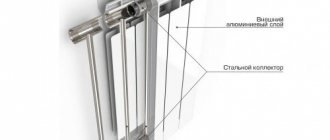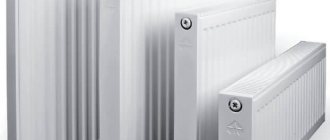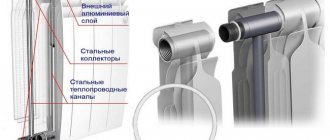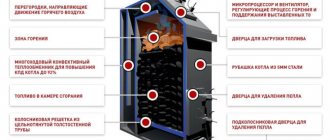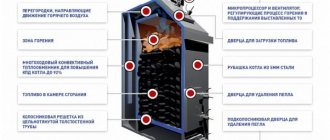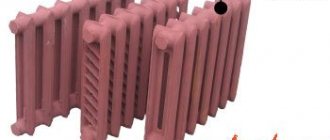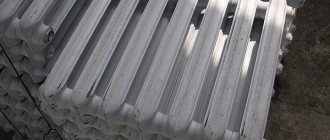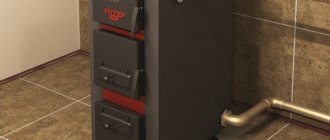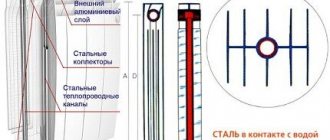Stationary batteries do not always provide a comfortable temperature regime. In particularly cold winters it is necessary to use additional heat sources. A good option is electric heating radiators, which by and large only include oil batteries.
In practice, this group includes all electric heating devices equipped with fins - this design best distributes heat. In the article we presented, all types of heating electrical equipment are analyzed in detail. Reliable information will help you decide on the best option for you.
Types of electric heating radiators
Electric radiators for heating are divided into several types. They differ in the method of heat transfer and internal structure.
When visiting specialized departments, you can encounter the following types:
- Fan heater;
- Convector;
- Oil radiator;
- Infrared heater.
To evaluate all the advantages and disadvantages of each device, we recommend that you familiarize yourself with the technical characteristics of each type.
What are fan heaters
Most positive reviews about this type of product claim that such heating devices have good efficiency. The design includes a fan and a heating element.
- The heated air is evenly distributed using a fan around the perimeter of the room.
- The heating elements are made in the form of tubes or spirals. The design includes a thermostat.
- Its operating principle is based on turning off the heater after reaching the desired temperature.
This part is responsible for the rotation speed of the fan blades. Thanks to it, it is possible to prevent overheating of the device during long-term operation.
Advantages and disadvantages of models
A floor-mounted electric radiator has the advantage of being able to maintain a certain temperature over large areas of the room. They provide quick heating of a closed space.
As for the disadvantages, they consist in the consumption of a large amount of electrical energy. Long-term work is accompanied by the combustion of oxygen in a closed space. Fans with a heating coil must not be used in rooms with high humidity.
Calculation of electricity consumption by an economical convector
Recently, manufacturers have been producing convectors with improved characteristics and call them economical. Whether using them really saves electricity will be shown by calculation.
For example, let’s take a well-insulated room with an area of 15 square meters. m., heated by an economical convector - Noirot with a power of 1500 W. We set the temperature to 20 °C, at an outside temperature of -5 °C.
Convector Noirot Spot-E3
Judging by the manufacturer's data, the room will warm up in 20 minutes. For initial heating the following is used:
0.33x1.5 = 0.5 kWh.
In order for the set temperature to be maintained, it is necessary for the convector to operate for 7 to 10 minutes. In one hour:
0.15x1.5 = 0.225 kWh.
8 hours of operation consumes electricity
0.225x8+0.5 = 2.3 kWh.
If we take into account that in the absence of people you can use the economical mode - from 10 to 12 degrees, the electricity consumption will be:
0.08x1.5x16 = 1.92 kWh.
In total, per day you will spend:
2.3+1.92 = 4.22 kWh.
Since a conventional convector consisting of several elements consumes from 6.8 to 7.5 kWh, then, according to the manufacturer, 2.58 - 3.28 kWh is saved.
Operating principle of an oil cooler
Oil-filled electric heating radiators must be filled with special mineral oil.
During operation, the heating component gradually increases the temperature of the liquid medium, which releases it through the walls of the housing.
Such devices do not have a spiral or heating flask in the public domain. The device does not burn oxygen and fine dust. What are the advantages of this model? These include:
- Safety;
- Design mobility;
- No noise during operation.
There are disadvantages, which include uneven heating of the enclosed space and increased temperature of the device body. In addition, the models are large in size, which affects their transportation.
Energy-saving electric radiators TERI
Let's consider another example when manufacturers' statements do not correspond to reality - TERI electric radiators, which, one might say, deceived physics. On their website we see the following:
As it was written earlier: the law of conservation of energy cannot be deceived; how much energy a device consumes, so much it releases. That is, if one section of an electric radiator consumes 75 W, then it will output 75 W. What is promised in this passage is absolutely impossible .
The same site provides a comparison of electricity consumption by various power systems:
It is worth noting that the graph is very strange and completely incomprehensible. At the top it is indicated that the heating operates 9 hours a day with a power of 2.07 kW, which means it supposedly spends 1490 kW per month - are these figures given only for the TERI system or for all of the listed systems? If 1490 kW per month is enough to heat a house with a TERI system, then why should other systems spend more? After all, the house is the same.
With the same power, all these types of electrical equipment will consume approximately the same amount of energy. It turns out very interestingly that when using gas heating, costs are higher than when using an electric boiler and electric convector. In fact, 1 kW of heat obtained by burning gas costs 50 kopecks ; 1 kW of heat received from electricity is obtained by spending 1 kW of electricity , and nothing else, which equals 4 rubles according to the tariff . That is, electric heating is always 8 times more expensive than gas heating.
Wall models
Wall-mounted electric heating radiators are equipped with a metal body and heating elements. They have a control panel and a timer. The convector does not evaporate moisture from oxygen and does not burn dust particles.
It is distinguished by its safety, easy operation and ultra-precise control, allowing a person to monitor the operation of the device.
- The operating principle of this device is based on the circulation of air masses.
- Cold air sinks down, and warm air slowly rises to the top.
- The cycle will repeat continuously unless the control panel is switched.
The only drawback of such a device is the lack of area for its mounting. Most models are distinguished by their impressive dimensions, which may not fit into the overall interior.
Color combinations
Stylists advise taking into account the following nuances:
- direction in the interior;
- combination of shades;
- illumination
It is much easier to choose a palette if the style for the kitchen and living room has already been selected. For example, neoclassicism and Provence have their own combinations. In a classic interior, designers combine pastel colors, pale colors, which are slightly diluted with dark shades. In French country houses you can often see soft blue, pink, and pistachio colors. Art Deco designers make up objects and finishing materials in black and white, sometimes beige and brown or silver and black. The main thing is to choose a shade for the walls. White will become universal, it will expand the space, and later you can paint them with any paint.
However, in the cooking area, white ceases to look fresh. Beige or gray shades would be more practical. This background will highlight the other colors. In a monochrome interior, designers recommend gluing wallpaper in an unusual color or with a photo print.
Description of infrared models
We recommend that you familiarize yourself with another type of electric radiator. Infrared models are considered new and high-quality products. The heater slowly heats the air masses inside the room.
Infrared rays help heat the surfaces of all objects that are in space. Manufacturers achieved this effect using electromagnetic waves that appear at a certain frequency.
During operation, the infrared radiator has a cold surface. The design includes shutdown sensors and a thermostat. Thanks to these details, the device is considered safe for independent use.
The advantages of such products are their simple installation and safe connection to the electrical network. Professionals claim that such models can provide rapid heating of air masses in a closed space and maintain it for 3 hours.
Thanks to several devices, it is possible to create a comfortable temperature in different parts of the room.
What are considered disadvantages? These include:
- Slow heating of the space;
- Cannot be used in rooms with high ceilings;
- It is regularly necessary to create a distance from the heating device to surrounding objects. The fact is that some surfaces can ignite when exposed to infrared rays;
- Price. The price for an electric heating radiator of this model is quite high.
How to make an electric battery yourself
If you are interested in organizing heating that is simple and inexpensive to install, make an electric battery with your own hands from an old cast-iron radiator. What you need to buy:
- Heating element with a power of 0.3-0.8 kW with a water thermostat;
- 2 end caps with gaskets;
- futorka with Mayevsky tap;
- room thermostat;
- wires with a cross section of 2.5 mm².
Note. Select the tubular electric heater according to the length of the radiator - the element must pass through all sections.
Assembling the electric battery is simple: install a heating element in the lower hole of the outer section, lubricating the gasket with high-temperature sealant. Screw the fitting into the opposite upper hole, open the Mayevsky tap slightly. Close the remaining side holes with plugs and fill the battery with water.
Connect the water thermostat, setting the maximum temperature to 80 °C to avoid boiling. Install a room thermostat and connect it with wires to the heating element. For details on how to make an electric battery, watch the next video:
Advantages of aluminum radiators
Recently, aluminum models of heating radiators have become in demand and popular. Thanks to them, it is possible to save electrical energy.
- They calmly react to changes in electrical voltage and are able to form an energy-saving autonomous unit.
- As for heat transfer, its level is three times higher than that of a cast iron and steel model.
- This criterion is associated with good thermal conductivity and an aluminum base.
They are ideal for spacious and small spaces. Equipment of this type consumes a minimal amount of electricity.

